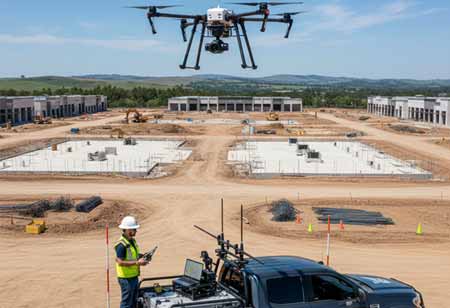THANK YOU FOR SUBSCRIBING
Be first to read the latest tech news, Industry Leader's Insights, and CIO interviews of medium and large enterprises exclusively from Applied Technology Review
Streamlining Construction Projects with EPC Contracts
In construction, poor management can quickly lead to wasteful projects that consume time and funds. As construction endeavours expand in scale and complexity

By
Applied Technology Review | Wednesday, November 08, 2023
Stay ahead of the industry with exclusive feature stories on the top companies, expert insights and the latest news delivered straight to your inbox. Subscribe today.
Summary: EPC contracts in construction reduce waste by hiring qualified contractors to manage entire projects from planning to completion, reducing risks and change requests.
FREMONT, CA: In construction, poor management can quickly lead to wasteful projects that consume time and funds. As construction endeavours expand in scale and complexity, the associated risks can make them appear particularly daunting. Enter engineering, procurement and construction (EPC) contracts meticulously designed to alleviate the burdens placed on project owners.
EPC contracts empower buyers by enabling them to enlist a qualified contractor to oversee the entire project lifecycle, from conception to completion. The contractor assumes full accountability for delivering a turnkey system or facility that adheres to pre-defined quality standards, timelines, and budget constraints. In this arrangement, much of the project's time, effort, and associated risks are effectively shifted onto the shoulders of a capable and trusted contractor.
Major Phases in an EPC project
EPC projects derive their name from the core services they encompass throughout the engagement: engineering, procurement, and construction. Beyond these fundamental components, project initiation and post-construction startup services are also integral.
The precise breakdown of these phases varies, contingent on the EPC contractor's internal procedures, delivery methods, and the specific project's characteristics. When the EPC contractor manages all these services, it offers the owner a streamlined turnkey delivery experience. Furthermore, it's customary for these project phases to exhibit overlapping elements, particularly when undertaken by seasoned EPC firms.
Planning
The initial phases of project planning go by various names, such as front-end planning (FEP), pre-project planning (PPP), front-end engineering design (FEED), front-end loading (FEL), and more. These terms describe the early steps to establish a project's approximate scope, budget, and schedule, develop a conceptual solution, and identify potential risks. In certain cases, this stage is a collaborative effort between the project owner and an EPC contractor, while in others, the owner collaborates with a consultant to complete pre-project planning before soliciting fixed-price proposals from EPC firms.
Many EPC projects follow a front-end loading (FEL) process, which offers a structured approach for owners to explore various conceptual options before selecting a solution and refining the design. The key advantage of this approach is that it enables owners to evaluate different strategies, design adjustments, and other modifications early in the process. This helps minimise the risk of change requests during the later stages of the project when they can be more costly and disruptive to implement.
The FEL process is divided into three levels, each requiring formal approvals at critical junctures. At FEL-1, owners review conceptual designs and choose one to advance to FEL-2, where they collaborate with engineers to assess concepts, estimate costs, make alterations, evaluate feasibility, and provide approval to proceed. In FEL-3, the chosen concept advances to the front-end engineering design (FEED) or basic engineering phase, where it is further developed to produce a more precise cost estimate and construction schedule, aiming for an accuracy level within ±10-15 per cent.
Engineering
The detailed engineering and design phase comes with a primary focus on creating comprehensive engineering plans for construction. During this phase, the EPC contractor transforms the initial conceptual ideas from earlier planning stages into a fully realised package. This package includes detailed functional descriptions, architectural blueprints, and structural and civil layouts, along with intricate diagrams encompassing piping, controls, instrumentation, electrical components, and mechanical systems. Due to its intricate nature, the detailed engineering process inherently involves collaboration among a diverse group of individuals, departments, and subject matter experts.
As the design matures, it brings into sharper focus the specifics related to equipment types, quantities, and layouts. This newfound clarity is invaluable, as the EPC contractor can then refine the project's budget and establish a more precise timeline for its completion.
Procurement
The procurement phase of the project represents a critical stage where the EPC contractor meticulously acquires all the requisite physical materials and services to construct the facility or system following specifications. This intricate process involves the procurement of diverse equipment, materials, and services from various vendors and suppliers, often employing competitive tender or bidding procedures. During this phase, the EPC contractor releases specifications and extends invitations to suppliers to submit offers and pricing.
To achieve success in the procurement phase of an EPC project, consider the following guidelines:
Source Strategically: Prioritise items with extended lead times and establish effective communication with suppliers to ensure the quality and timely delivery of procured goods. This proactive approach guarantees that essential components are ready for deployment when needed.
Develop Comprehensive Timelines: The primary objective of procurement is to ensure that construction teams have access to the required resources at the right time. By crafting detailed timelines to map out procurement and delivery schedules, all stakeholders gain clarity on expectations and can identify and address potential scheduling challenges before they cause delays.
Construction
The construction phase of an EPC project is when the contractor transforms the envisioned facility or system into a tangible reality, adhering to the specifications laid out in earlier project phases. This transformation can involve various methods, such as prefabricating system components in off-site fabrication shops and then transporting them to the project location, constructing the system on-site, or integrating various components on the project site. EPC contractors may either possess their own fabrication facilities or subcontract fabrication work to external vendors, with the key requirement being effective communication throughout the project.
A well-executed project planning process in the earlier stages is instrumental in facilitating a construction phase marked by minimal issues or delays. Nevertheless, there are some essential recommendations for achieving success during the construction phase of an EPC project:
Establish Change Management: Robust change management protocols should be put in place during the project's earlier phases. These protocols should encompass clear criteria for evaluating the appropriateness of any proposed changes and offer guidance for executing and documenting change requests. The objective is to transparently communicate the impacts on cost and timeline, thereby keeping all stakeholders informed.
Involve the Design Team: Even during the construction phase, it is crucial to maintain the involvement of the design team. Their continued participation in the project serves to clarify aspects of the project plans and offers valuable assistance in managing change requests effectively. This ongoing collaboration helps ensure that the construction aligns with the original design intent and any necessary alterations are well-coordinated.
Before the turnover of a facility or system to its owner, a series of commissioning and start-up activities must be meticulously carried out to ensure the system or facility operates safely and follows its intended functionality. The initial step in this process is pre-commissioning, primarily undertaken by the fabricator, encompassing tests, cleaning of system components, pipe flushing, and leak checks. Subsequently, commissioning tasks involve safety mechanism and control testing, calibration, system control and component integration, as well as troubleshooting and issue resolution. Notably, testing at this stage typically uses inert substances like water and air rather than actual process chemicals for safety reasons. Finally, the project transitions to start-up services, including new equipment and systems online, performance testing, and the ultimate handover of operations to the owner.
I agree We use cookies on this website to enhance your user experience. By clicking any link on this page you are giving your consent for us to set cookies. More info








